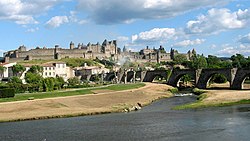
Back Aude (rivier) Afrikaans Од Bulgarian Aude (stêr) Breton Riu Aude Catalan Aude (suba sa Pransiya) CEB Aude (řeka) Czech Afon Aude Welsh Aude (flod) Danish Aude German Ωντ (ποταμός) Greek
| Aude | |
|---|---|
 The Aude at Carcassonne | |
 | |
| Native name | L'Aude (French) |
| Location | |
| Country | France |
| Physical characteristics | |
| Source | |
| • location | Les Angles, Lac d'Aude, Massif du Carlit, Pyrénées, France |
| • elevation | 2,136 m (7,008 ft) |
| Mouth | |
• location | Fleury/Vendres, France, Mediterranean Sea |
• coordinates | 43°12′45″N 3°14′25″E / 43.21250°N 3.24028°E |
• elevation | 0 m (0 ft) |
| Length | 224.1 km (139.2 mi)[1] |
| Basin size | 6,074 square kilometres (2,345 sq mi) total and 4,900 square kilometres (1,900 sq mi) above Coursan[2] |
| Discharge | |
| • average | 43.6 m3/s (1,540 cu ft/s) at Moussan[3] |
| Basin features | |
| Tributaries | |
| • left | the Cesse, the Fresquel, the Orbiel, the Argent-Double, the Trapel, the Sou de Val de Daigne |
| • right | the Orbieu, the Sals, the Lauquet |
 | |
The Aude (French pronunciation: [od] ⓘ; Occitan: [ˈawðe]; Latin Atax [ˈataks]) is a river of southern France that is 224 kilometres (139 mi) long.[1] Its source is in the Pyrenees mountains then runs to Carcassonne and finally reaches the Mediterranean Sea near Narbonne. The river is navigable by raft or canoe for nearly all of its length. It is registered as essential to the Languedoc-Roussillon region.
The river gave its name to the Aude department.
- ^ a b Sandre. "Fiche cours d'eau - L'Aude (Y1--0200)". (in French)
- ^ Hydro Bank - The Aude at Coursan Archived 2021-11-22 at the Wayback Machine, Ministry of Ecology, Sustainable Development and Energy, consulted on 17 February 2013 (in French)
- ^ Hydro Bank - The Aude at Moussan (1965–2009) Archived 2021-11-22 at the Wayback Machine, Ministry of Ecology, Sustainable Development and Energy, consulted on 17 February 2013 (in French)